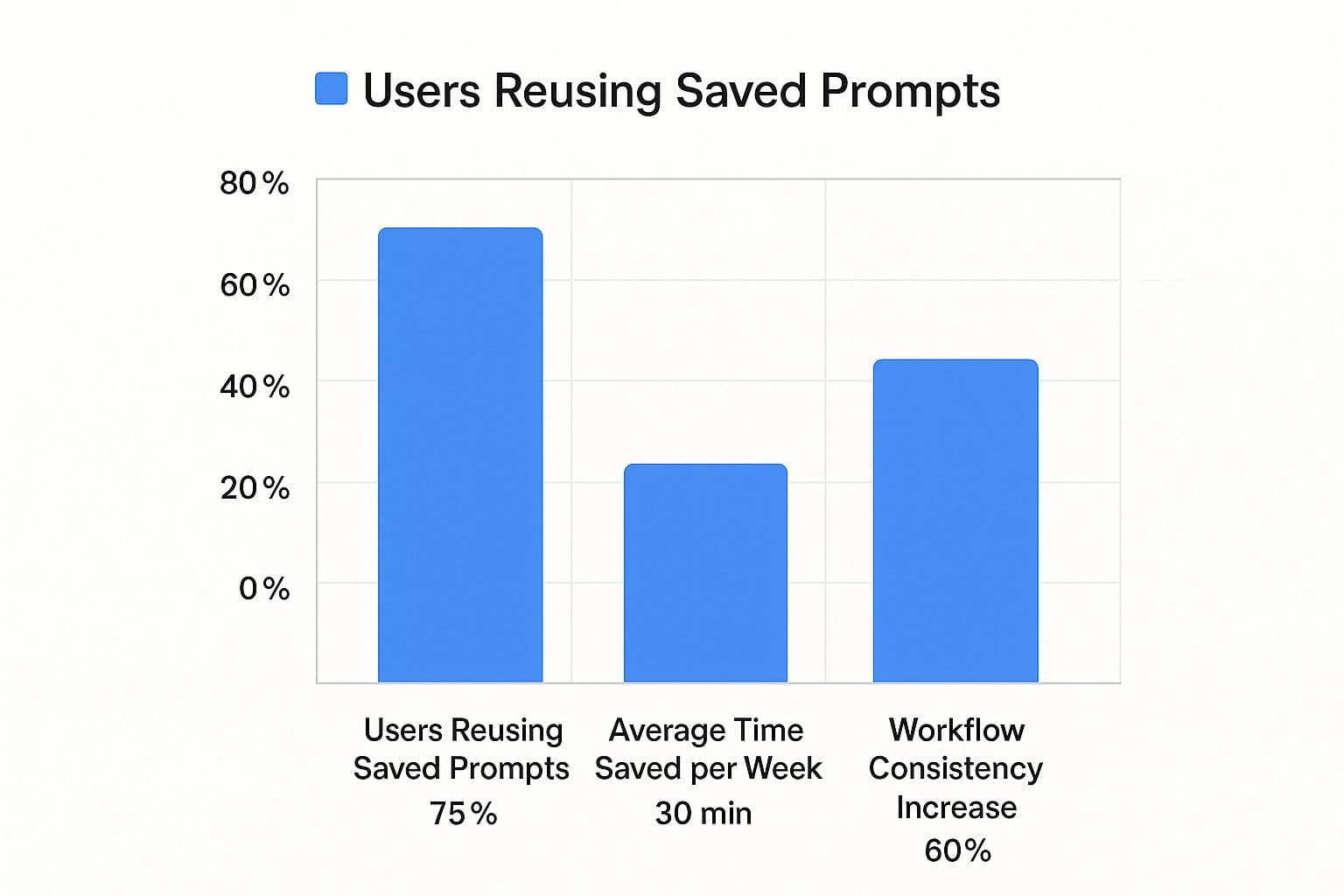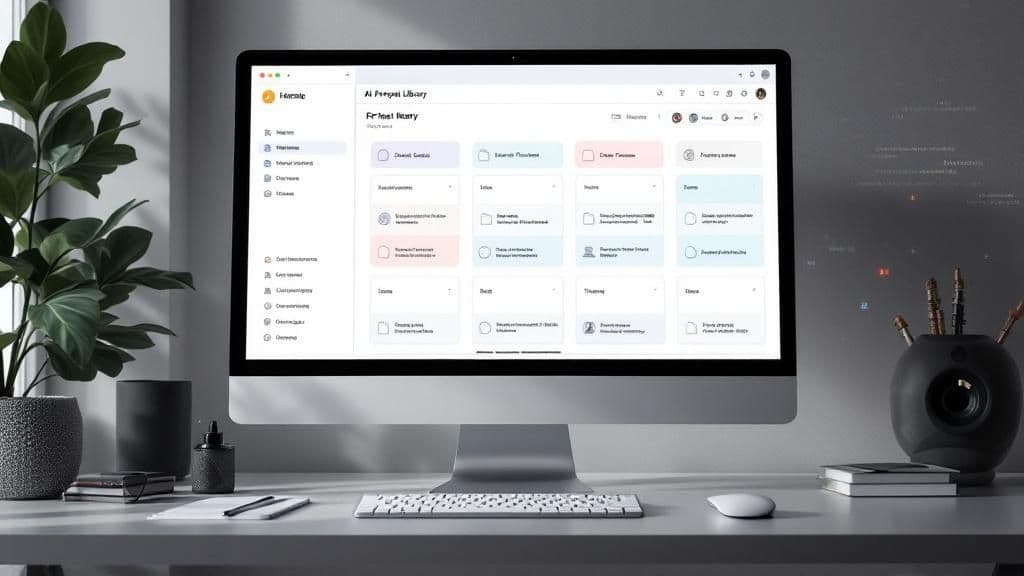How to Save AI Prompts and Boost Your Productivity
Discover how to save AI prompts to streamline your workflow. Learn practical tips for building a personal prompt library and using it to work faster.

If you want to save AI prompts the right way, you need a mental shift. Stop seeing AI as a tool for one-off tasks and start thinking of it as your personal productivity engine. This is about building a reusable, organized system for your most effective text-based instructions. By storing your best prompts in one central place—whether a simple notes app or a dedicated tool—you can automate daily tasks, streamline your communication, and get more done in less time. It’s a simple habit that turns your AI from a fun novelty into a powerful assistant for your daily life.
Why Manually Typing Every AI Prompt Is Wasting Your Time
Do you ever feel like you're having the same conversation with your AI assistant every single day? You spend ten minutes crafting the perfect prompt to summarize your meeting notes into action items, and it works brilliantly. Then, a week later, you're back at square one, trying to remember the exact phrasing that delivered such great results.
This cycle of reinventing the wheel is a silent productivity killer.
Starting from scratch with every AI interaction drains more than just time; it zaps your creative energy. That mental effort you spend trying to recall the magic words could be better spent on work that actually matters—like strategic thinking or creative problem-solving. This is where the simple but powerful habit of saving your prompts comes into play.
The Hidden Costs of Reinventing the Wheel
Prompt management is just a fancy term for saving, organizing, and reusing your best AI instructions. It’s a fundamental change in how you work with text. Instead of treating each AI chat as a one-off, you start building a personal library of reliable commands that deliver consistent, high-quality results for your everyday tasks. It’s a small change that brings a ton of predictability and efficiency to your daily grind.
Think about the compounding effect of saving just a few minutes here and there. Those minutes quickly add up to hours every month—hours you can pour back into strategic projects or just leaving the office on time. The whole point of saving prompts is to get rid of redundant effort and automate repetitive tasks in your workflow.
Let's break down what this looks like in practice.
The Hidden Costs of Not Saving Your Prompts
This table gives you a quick side-by-side look at the old, manual way versus a more systematic approach. The difference is pretty stark when you see it laid out.
| Metric | Manual Prompting (The Old Way) | Saved Prompt System (The New Way) |
|---|---|---|
| Time Spent | 5-10 minutes per complex task | <30 seconds to find and use a saved prompt |
| Output Quality | Inconsistent, varies with your memory | Consistently high, based on proven prompts |
| Mental Energy | High. Constant brainstorming required. | Low. Just find, copy, paste, and tweak. |
| Onboarding Team | Slow. Everyone has to learn from scratch. | Fast. Share your prompt library with new hires. |
As you can see, sticking with the manual method isn't just slower—it's actively holding you back from getting the most out of your AI tools.
The infographic below really drives home the productivity gains people see when they finally start saving their prompts.

The data doesn't lie. A huge majority of people who adopt a prompt-saving habit don't just get time back—they also see a big jump in the consistency and quality of their work.
Moving From Simple Tool to Personal Assistant
When you save your AI prompts, you’re essentially training a personal assistant that already knows your specific needs, tone, and communication style. This makes your daily text-based work much faster and more effective.
This approach lets you:
- Guarantee Quality and Consistency: A saved prompt for "Rewrite this email in my professional but friendly tone" will always nail your personal or brand voice, getting rid of any weird variations.
- Speed Through Repetitive Tasks: Need to draft a follow-up email, generate a quick social media caption, or summarize an article? You can do it in seconds with a pre-built instruction.
- Reduce Your Cognitive Load: Free up your brainpower. Stop trying to remember complex prompts for common tasks like scheduling meetings or drafting project updates. Let your system do the heavy lifting.
By systematizing your AI interactions, you’re not just saving a few seconds. You’re building an intelligent workflow that makes your daily tasks faster, more effective, and a whole lot less repetitive.
Building Your First Prompt Library the Simple Way
Getting started with a prompt library doesn't have to be complicated. Forget fancy software for now. The best way to begin is with the tools you already use every day—think Google Docs, Apple Notes, or even a plain old text file. The goal isn't to build the perfect system on day one; it's to start the habit of saving what works for your daily life.
Think of it like a personal cookbook for productivity. Each time you craft a prompt that gives you a fantastic result—whether it's the perfect email response or a concise summary of a report—you save that "recipe." This simple act is your first step toward making your AI interactions less of a guessing game and more of a predictable, powerful tool.
Start with Simple Categories
A messy library is a useless library. If you have to scroll through a giant, disorganized document to find the one prompt you need, you’ll just give up. The trick is to start with a few basic categories that reflect your actual day-to-day work.
A few ideas to get you started:
- Email Management: For prompts that draft replies, shorten your messages, or adjust the tone from formal to casual.
- Meeting Productivity: A spot for your go-to prompts for creating agendas, summarizing notes, and listing action items.
- Content Creation: Perfect for recurring text tasks, like writing social media captions, brainstorming ideas, or outlining a report.
- Learning & Summarization: For prompts that are great at boiling down long articles, reports, or videos into key takeaways.
This approach is all about organizing your digital knowledge so it’s easy to find and use later. It’s a core idea behind concepts like how to build a Second Brain with AI, where you capture and connect valuable information—in this case, your best AI prompts.
What to Include in Each Entry
For your library to actually be helpful down the road, you need to add a bit of context. Just copying and pasting the prompt text itself won't cut it. In three months, you won't remember why that specific wording was so effective.
A solid entry should have three key pieces of information:
- The Prompt Itself: The exact text you fed the AI.
- A Short Description: A quick one-liner explaining its purpose. (e.g., "Generates three professional but friendly subject lines for a follow-up email.")
- Output Note: A quick comment on what kind of result you get. (e.g., "Gives me a bulleted list of options.")
Here’s a glimpse of how this looks in a dedicated tool like TypeBoost, which keeps everything clean and organized.

With this structure, finding and reusing the right prompt becomes incredibly fast. If you want to dive deeper, we have a whole guide on creating a powerful https://www.typeboost.ai/en/blog/ai-prompt-library that’s worth a read.
Getting this habit down now is more important than you might think. The AI market is already valued at around $391 billion and is on track to grow almost five times larger in the next five years. And right at the heart of it is prompt engineering. In fact, over 45% of professionals believe it will be one of the most in-demand AI skills. Learning to manage your prompts today is a smart move for your future.
Key Takeaway: Your first prompt library should be simple. Use tools you know, organize it around your real-world tasks, and focus on building the habit. You can always upgrade your system later.
Leveling Up with Dedicated Prompt Management Tools
So, your trusty text file or notes app is starting to feel a little... crowded. If it's overflowing with saved prompts, that's actually great news! It means you're getting into the habit of saving and reusing what works. But when you spend more time scrolling than working, you've hit a wall. It's time for an upgrade.
This is where dedicated prompt management tools come in.

These apps are built from the ground up to save AI prompts and weave them directly into your workflow. They're not just about storage. Think of them as command centers for your daily productivity. Some are browser extensions that live right inside your AI chat tool, while others are standalone desktop apps, like TypeBoost, that work everywhere on your computer.
No matter the flavor, the mission is the same: get your best prompts in your hands the moment you need them, wherever you are.
The Power of Instant Access and Smart Features
A dedicated tool brings a kind of speed and smoothness that a simple text file just can't touch. These are designed for real-world productivity, packed with features that genuinely make your daily text-based work easier and faster.
Forget digging through files. Imagine pulling up your entire prompt library with a quick keyboard shortcut. You hit a key combo, type a keyword for "meeting summary," and boom—your perfectly polished prompt is ready to roll. That one change can completely reshape how quickly you get things done.
But it goes way beyond shortcuts. These tools bring some serious power-ups to the table:
- Dynamic Variables: This is a total game-changer for productivity. You can create templates with placeholders like
{{client_name}}or{{project_details}}. When you call up the prompt, the app will ask you to fill in those details on the fly. No more manual find-and-replace for every email or report. - Team Collaboration: Suddenly, your personal library becomes a shared playbook for your whole team. Everyone gets access to the same battle-tested prompts for marketing campaigns, customer support responses, or project updates. It keeps communication consistent and helps new team members get up to speed in a fraction of the time.
- Cross-App Functionality: This is where desktop apps really shine. They let you use your saved prompts in any program—your email client, your document editor, your project management tool, you name it. The wall between your prompt library and your actual work just disappears.
When you switch to a dedicated manager, you're doing more than just organizing text. You're building a smart, connected system that puts your best instructions one keystroke away, everywhere you type.
This isn't just a niche trend; it's a massive shift. The prompt engineering market was valued at an eye-watering USD 380.12 billion in 2024. And it's not slowing down—it's projected to soar to nearly USD 6.53 trillion by 2034. That explosive growth is all about the demand for tools that make AI more personal and powerful. You can dig into the numbers yourself in the full research on the prompt engineering market.
Putting It All Together
With a tool like TypeBoost, you can start building a real system. Organize prompts by project. Tag them so they're easy to find. You can even borrow and adapt prompts from a community hub.
The goal is to find a system that helps you use AI more efficiently by cutting out all the boring, repetitive steps. Your prompt library goes from a static list of text to a living, breathing resource that grows and evolves with you and your team.
How to Write Prompts That Are Actually Worth Saving
Having a system to save AI prompts is great, but let's be real—if your prompts are vague, your fancy library won't do you any good. The whole point is to get meaningful benefits and save time, and that starts with crafting precise, powerful instructions that deliver value every time you use them.
A great prompt is like giving a GPS a specific street address instead of just telling it to "drive downtown." The more detail and context you provide, the more productive your interaction will be. Forget one-line commands. Think of it more like writing a mini-brief for a very literal-minded (but incredibly fast) assistant.
From Vague Ideas to Precise Instructions
So, what separates a mediocre prompt from a fantastic one? It usually boils down to four things: context, persona, format, and constraints. When you weave these together, you turn a simple request into a repeatable, high-value asset for your daily productivity.
Let's look at a quick "before and after" to see this in action.
Before (The Vague Prompt):
"Write a social media post about my new product."
This is a recipe for a generic, uninspired post. The AI has no clue about your product, your audience, or your goal. You’re leaving way too much up to chance, which means you'll have to do more editing later.
After (The Prompt Worth Saving):
"Act as a friendly and knowledgeable social media manager for a small business that sells handmade leather journals. Write an engaging Instagram caption for a new product launch. The tone should be warm, artisanal, and slightly nostalgic. The post must be under 150 words, include three relevant hashtags, and end with a clear call-to-action inviting followers to click the link in our bio."

See the difference? This version is specific and gives the AI a clear roadmap to a high-quality result. Better yet, it's a reusable template. You can easily swap out the product details for your next launch and get consistently great content. If you really want to get good at this, you'll need to master the art of prompt engineering so you can create instructions like this on autopilot.
The Core Building Blocks of a Great Prompt
To make your prompts truly effective and reusable, they need to have some structure. Think about baking these components into every prompt you save.
- Define the Persona: Tell the AI who it should be. Is it a "witty marketing expert," a "helpful customer service agent," or a "professional technical writer"? This one instruction dramatically shapes the tone and style.
- Provide Clear Context: Don't make the AI guess. Give it the necessary background. Who's the audience? What's your brand's mission? What specific problem is this content trying to solve?
- Specify the Output Format: If you don't tell the AI how you want the information, you'll get a wall of text. Be explicit. Ask for a "bulleted list," a "three-paragraph email," a "table with two columns," or even a "JSON object" for technical tasks.
- Use Constraints: Set some ground rules to guide the AI. Things like "keep it under 200 words," "use simple language," or "do not include any technical jargon" are incredibly helpful for getting the exact output you need.
By building your prompts with these elements, you're not just asking a question; you're creating a framework for consistent, high-quality answers. This is the real foundation of a prompt library that helps you produce better work, faster.
Want to go deeper on this? Our guide on https://www.typeboost.ai/en/blog/how-to-write-ai-prompts breaks down even more techniques and examples. Honing this skill is what transforms a simple collection of prompts into a genuine productivity machine.
Making Saved Prompts a Part of Your Everyday Flow
Having a library to save AI prompts is great, but the real magic happens when you integrate them into your daily habits. The idea is to make using your best prompts as quick and instinctive as hitting Ctrl+C. This is where you move from just collecting prompts to actively boosting your productivity with them.
Think about all the little, repetitive text-based tasks you do every day. Writing a follow-up email, turning messy meeting notes into a clean summary, or drafting a social media post in your brand's voice—these are all perfect opportunities to use a saved prompt and get meaningful time back.
How This Looks in the Real World
Picture this: you've just wrapped up a long client call. Instead of staring at a blank page, you highlight your jumbled notes, use a quick shortcut, and fire up your "Summarize Meeting Notes into Action Items" prompt. A few seconds later, you’ve got a perfectly formatted, bulleted list ready to send out to your team.
Here are a few other ways this can improve your daily productivity:
- Taming Your Inbox: A saved prompt can take a blunt, one-line request and instantly flesh it out into a polite, professional email that sounds exactly like you.
- Whipping Up Content: Got an idea for a post? A "Generate Instagram Caption" prompt can spin it into on-brand copy, complete with the right hashtags, in seconds.
- Learning Faster: Stumble across a dense article or some technical jargon? Your "Explain This Like I'm a Beginner" prompt can break it down for you in simple terms instantly.
The real unlock is when you stop thinking of AI as a separate destination and start seeing it as a command you can run on top of whatever you're already doing. That's how you start getting hours back each week.
This isn't just a neat trick, either. The ability to craft, save, and weave prompts into workflows is becoming a seriously valuable skill. Prompt engineering is a legitimate career path now, with some top pros pulling in salaries over $270,000. Companies need people who can translate human ideas into machine instructions, and that’s a skill that has more to do with language than code. You can get the full scoop on this growing field in this prompt engineering salary guide.
Level Up with Prompt Chains
Once you've mastered using individual prompts in your daily routine, the next step is to "chain" them together. This is an advanced productivity technique where the output from one of your saved prompts becomes the input for the next. It’s like setting up a mini assembly line for your text-based work.
By doing this, you can build sophisticated workflows that handle multi-step tasks without you having to copy and paste between each step.
Here’s a practical example of a prompt chain for content creation:
- Kick things off with an idea. Start with a broad prompt like, "Brainstorm five blog post titles about the benefits of time blocking for freelancers."
- Build the skeleton. Pick your favorite title, then feed it into your next saved prompt: "Create a detailed five-section blog post outline for the title: [Insert Title Here]."
- Write the opening. Now, grab the first point from that outline and pop it into a third prompt: "Write a compelling 150-word introduction based on this outline point: [Insert Outline Point Here]."
Just like that, you’ve gone from a vague idea to a structured outline and a drafted intro in a matter of moments. Because each step uses a trusted, pre-built prompt from your library, the quality and consistency stay high. You've essentially turned a few simple commands into your own personal productivity engine.
Got Questions About Saving Your AI Prompts?
So, you're sold on the idea of saving your AI prompts to be more productive. That's great! But moving from theory to practice often brings up a few nagging questions. It's one thing to know why you should build a prompt library, but it's another thing entirely to manage it day-to-day without it becoming a mess.
Let's dive into some of the most common questions people have when they start getting serious about their prompt game.
"How Often Should I Bother Updating My Prompts?"
This is a big one. The short answer? Your prompt library should be a living, breathing tool—not some dusty archive you set and forget.
Think about it: the AI models we use are constantly being updated. A killer prompt that got you amazing results with GPT-4 six months ago might feel a little flat with the latest version. A good rule of thumb is to give your most-used prompts a quick check-up every few months to ensure they're still delivering top-notch results.
If you start noticing the quality of the AI's output dipping, that's your signal. It's time to refine the prompt and see if a little rewording can bring it back up to speed for better daily use.
"What About Super Complex Prompts with Variables?"
Okay, what about those prompts for recurring tasks that need different details each time, like client names, project specs, or specific data points? Manually swapping out those details every single time is a total drag and defeats the purpose of being productive.
This is exactly why you need a system that handles dynamic variables (or placeholders). A solid prompt manager will let you build templates with fields like {{client_name}} or {{product_description}}.
When you fire up the prompt, the tool simply asks you to fill in the blanks. It then plugs your custom text into the right spots automatically. This turns a monster instruction into a quick, fill-in-the-blanks task.
This approach gives you the best of both worlds: the consistency of a finely tuned prompt with the flexibility you need for every new project. It's a key feature for anyone serious about using AI to boost their daily productivity.
"How Do I Keep My Prompt Library Organized as It Grows?"
It’s easy to manage a dozen prompts. But what happens when you have 50? Or 100? A library is only useful if you can find what you're looking for without a 10-minute search party.
The secret to a scalable system is a smart mix of categories and clear naming conventions that reflect your daily life and work.
- Start with big buckets: Group your prompts by function. Think
Marketing Copy,Coding Help,Email Drafts, orMeeting Summaries. - Get specific with titles: Don't just call it "Email prompt." Name it something like "Polite Follow-Up Email to Unresponsive Client." You should know exactly what it does just by reading the title.
- Tag everything: For next-level organization, use tags. You could use
#internal,#clientfacing, or#blogpost. This lets you find related prompts even if they live in different categories, making your library a truly productive asset.
This kind of structure is what keeps your library from turning into a digital junk drawer. It stays a powerful, searchable resource you'll actually want to use.
Ready to stop juggling text files and finally build a prompt library that works everywhere? TypeBoost gives you a central command palette for all your best AI prompts, accessible with a simple keyboard shortcut in any app. No more copy-pasting, no more context switching—just instant results. Start your free trial of TypeBoost today and feel the difference.